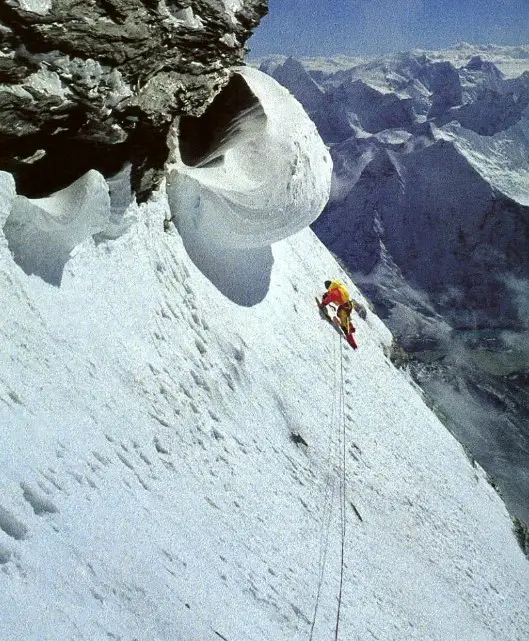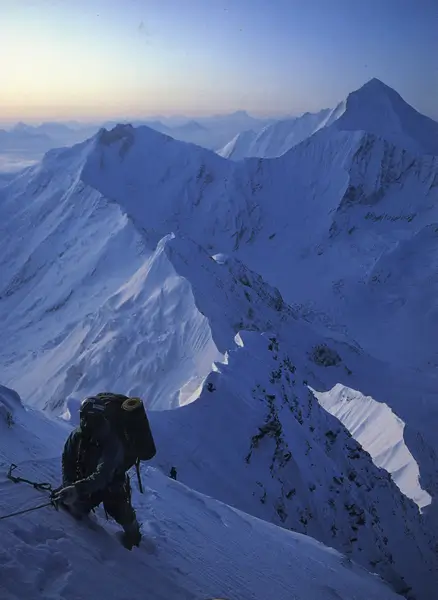What Is Alpine Style Climbing? Why It’s the Gold Standard
In the world of high-altitude climbing, there are many ways to reach a summit – but few methods are as revered (and as demanding) as alpine style. Often referred to as the “purest form of mountaineering,” alpine style emphasizes speed, self-reliance, and minimalism. For many elite alpinists, it’s not just a technique – it’s a philosophy.
So what exactly is alpine style climbing, and why do so many consider it the ultimate expression of skill, commitment, and respect for the mountain?

Christophe Profit on a two-men team attempt on the South Face of Lhotse, back in 1990. Climbing mate Pierre Béghin took the photo.
What Is Alpine Style Climbing?
Alpine style climbing is a minimalist, fast-and-light approach where climbers ascend a mountain without fixed ropes, without supplemental oxygen, and without established camps or external support. All necessary gear – food, shelter, climbing tools – is carried from the start, and the ascent is continuous from base to summit and back.
Key Characteristics:
- No pre-established camps or porter support
- No fixed ropes or siege-style logistics
- Light loads and minimal equipment
- Climbing in a single continuous push
- Emphasis on speed, efficiency, and self-sufficiency
Alpine vs. Expedition (Siege) Style:
Expedition style relies on fixed camps, stocked gear, porters, and often weeks of preparation on the mountain. Alpine style strips that all away – it’s just the climbers and the climb.
Why Alpine Style Is Considered the Gold Standard
Pure Challenge
Alpine style tests every facet of a climber – strength, endurance, navigation, decision-making, and mental toughness. There’s no backup plan, no retreat to a stocked camp. Success demands mastery.
Minimal Environmental Impact
This approach leaves little to no trace. With fewer fixed ropes, no stocked camps, and less waste, alpine style aligns with Leave No Trace principles and preserves the mountain’s natural state.
Faster and More Efficient
Carrying less and moving faster means reduced exposure to altitude and weather hazards. While risk is still high, the duration of exposure is lower – sometimes increasing safety overall.
Ethical Climbing Philosophy
Many top alpinists see alpine style as the most ethical way to climb – one that honors the mountain by not overpowering it with manpower and logistics.
Iconic Alpine Style Ascents
Reinhold Messner & Peter Habeler – Everest 1978: No supplemental oxygen – a milestone in alpine-style ethos at extreme altitude.
Steve House & Vince Anderson – Nanga Parbat 2005: Light and fast on the Rupal Face, this climb earned them the Piolet d’Or.
Ueli Steck – Solo Ascent of Annapurna South Face, 2013: A controversial but legendary solo climb in pure alpine style
The Risks of Alpine Style
- Limited Backup: No resupply or retreat points. If something goes wrong, you’re on your own.
- Weather Vulnerability: A storm at altitude with no shelter options can quickly turn deadly.
- Mental and Physical Stress: Requires extreme stamina, high-altitude adaptation, and precise decision-making under pressure.

Is Alpine Style for You?
If you:
- Have extensive alpine experience
- Are acclimatized to high altitudes
- Can navigate terrain with limited support
- Value the purity and intensity of the climb
…then alpine style might be your calling.
However, it’s not about ego. The style you choose should serve the mountain, the objective, and your safety. In some contexts – especially extremely high-altitude or remote expeditions – a hybrid or light expedition style might be more practical.
Final Thoughts
Alpine style climbing is not just a method – it’s a mindset. It’s about moving efficiently, climbing ethically, and embracing the raw challenge of the mountains. For those who dare to ascend this way, the rewards are unmatched: not just the summit, but the profound satisfaction of doing it on your own terms.
